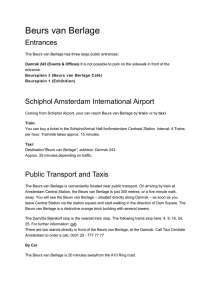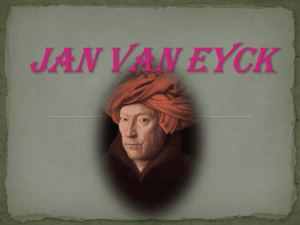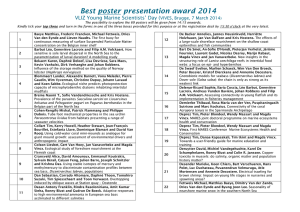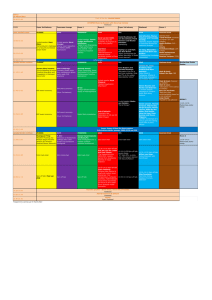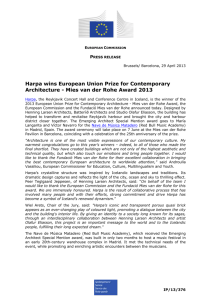Clean air. Spacious housing. Lush nature. Clear water. Quality
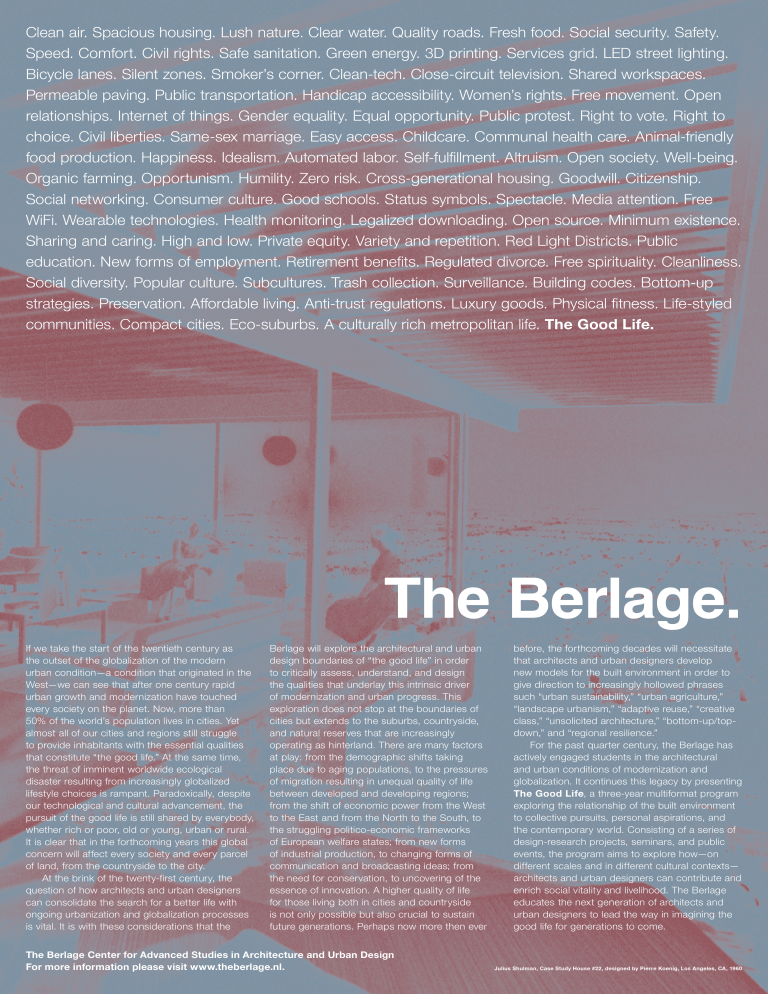
Clean air. Spacious housing. Lush nature. Clear water. Quality roads. Fresh food. Social security. Safety.
Speed. Comfort. Civil rights. Safe sanitation. Green energy. 3D printing. Services grid. LED street lighting.
Bicycle lanes. Silent zones. Smoker’s corner. Clean-tech. Close-circuit television. Shared workspaces.
Permeable paving. Public transportation. Handicap accessibility. Women’s rights. Free movement. Open relationships. Internet of things. Gender equality. Equal opportunity. Public protest. Right to vote. Right to choice. Civil liberties. Same-sex marriage. Easy access. Childcare. Communal health care. Animal-friendly food production. Happiness. Idealism. Automated labor. Self-fulfillment. Altruism. Open society. Well-being.
Organic farming. Opportunism. Humility. Zero risk. Cross-generational housing. Goodwill. Citizenship.
Social networking. Consumer culture. Good schools. Status symbols. Spectacle. Media attention. Free
WiFi. Wearable technologies. Health monitoring. Legalized downloading. Open source. Minimum existence.
Sharing and caring. High and low. Private equity. Variety and repetition. Red Light Districts. Public education. New forms of employment. Retirement benefits. Regulated divorce. Free spirituality. Cleanliness.
Social diversity. Popular culture. Subcultures. Trash collection. Surveillance. Building codes. Bottom-up strategies. Preservation. Affordable living. Anti-trust regulations. Luxury goods. Physical fitness. Life-styled communities. Compact cities. Eco-suburbs. A culturally rich metropolitan life.
The Good Life.
If we take the start of the twentieth century as the outset of the globalization of the modern urban condition—a condition that originated in the
West—we can see that after one century rapid urban growth and modernization have touched every society on the planet. Now, more than
50% of the world’s population lives in cities. Yet almost all of our cities and regions still struggle to provide inhabitants with the essential qualities that constitute “the good life.” At the same time, the threat of imminent worldwide ecological disaster resulting from increasingly globalized lifestyle choices is rampant. Paradoxically, despite our technological and cultural advancement, the pursuit of the good life is still shared by everybody, whether rich or poor, old or young, urban or rural.
It is clear that in the forthcoming years this global concern will affect every society and every parcel of land, from the countryside to the city.
At the brink of the twenty-first century, the question of how architects and urban designers can consolidate the search for a better life with ongoing urbanization and globalization processes is vital. It is with these considerations that the
The Berlage.
Berlage will explore the architectural and urban design boundaries of “the good life” in order to critically assess, understand, and design the qualities that underlay this intrinsic driver of modernization and urban progress. This exploration does not stop at the boundaries of cities but extends to the suburbs, countryside, and natural reserves that are increasingly operating as hinterland. There are many factors at play: from the demographic shifts taking place due to aging populations, to the pressures of migration resulting in unequal quality of life between developed and developing regions; from the shift of economic power from the West to the East and from the North to the South, to the struggling politico-economic frameworks of European welfare states; from new forms of industrial production, to changing forms of communication and broadcasting ideas; from the need for conservation, to uncovering of the essence of innovation. A higher quality of life for those living both in cities and countryside is not only possible but also crucial to sustain future generations. Perhaps now more then ever before, the forthcoming decades will necessitate that architects and urban designers develop new models for the built environment in order to give direction to increasingly hollowed phrases such “urban sustainability,” “urban agriculture,”
“landscape urbanism,” “adaptive reuse,” “creative class,” “unsolicited architecture,” “bottom-up/topdown,” and “regional resilience.”
For the past quarter century, the Berlage has actively engaged students in the architectural and urban conditions of modernization and globalization. It continues this legacy by presenting
The Good Life
, a three-year multiformat program exploring the relationship of the built environment to collective pursuits, personal aspirations, and the contemporary world. Consisting of a series of design-research projects, seminars, and public events, the program aims to explore how—on different scales and in different cultural contexts— architects and urban designers can contribute and enrich social vitality and livelihood. The Berlage educates the next generation of architects and urban designers to lead the way in imagining the good life for generations to come.
The Berlage Center for Advanced Studies in Architecture and Urban Design
For more information please visit www.theberlage.nl.
Julius Shulman, Case Study House #22, designed by Pierre Koenig, Los Angeles, CA, 1960
Tutors since 2012
Matthias Armengaud
Tom Avermaete
Ido Avissar
Laura Baird
Henriette Bier
Ole Bouman
Johanne Borthne
Matthijs Bouw
Sanne van den Breemer
Alessandra Cianchetta
Jean-Louis Cohen
Brendan Cormier
Rients Dijkstra
Amir Djalali
Victoria Easton
Georgios Eftaxiopoulos
Salomon Frausto
Gary Freeman
Mauricio Freyre
Dick van Gameren
Filip Geerts
Olaf Gipser
Reinier de Graaf
Ulf Hackauf
Alexandra den Heijer
Herman Hertzberger
Dirk van den Heuvel
Daniel Jauslin
Marcus Kempers
Hamed Khosravi
Diederik de Koning
Jorn Konijn
Karin Laglas
Sang Lee
Dietmar Leyk
Sylvia Libedinsky
Enriqueta Llabres
Sébastien Marot
Francesco Marullo
Stefano Milani
Nelson Mota
Billy Nolan
Don Murphy
Freek Persyn
Mark Pimlott
Giorgio Ponzo
Andrej Radman
Eduardo Rico
Nanne de Ru
Marc Schoonderbeek
Lara Schrijver
Heidi Sohn
Laurens Tait
Oliver Thill
Pier Paolo Tamburelli
Madelon Vriesendorp
Jung Hyun Woo
Experts and discussants
Sanderyn Amsberg
Marc Armengaud
Emre Arolat
Guus Beumer
Clément Blanchet
Mark Brearley
Herman van Bergeijk
Gro Bonesmo
Pippo Ciorra
Lieven De Cauter
Frits van Dongen
Henk Engel
Alain Fouraux
Beatrice Galilee
Christoph Gantembein
Anne Holtrop
Arjan van de Lindeloof
Kees Kaan
Tracy Metz
Kiel Moe
Iradj Moeini
Bert Mulder
Sander Mulders
Betty Ng
Billy Nolan
Joe Osae-Addo
Michelle Provoost
Cornelia Redeker
Michiel Riedijk
Vincent de Rijk
Joost Schrijnen
Malkit Shoshan
Dirk Sijmons
Martin Sobota
Martino Tattara
Arjan van Timmeren
Jan de Vylder
Thijs Welman
Saskia de Wit
Elia Zenghelis
Lecturers
Lara Almarcegui
Emre Arolat
Charles Bessard
Nicolas Lobo Brennan
Petra Blaisse
Liza Fior
Adriaan Geuze
Maarten Gielen
Stefano Graziani
Go Hasegawa
Patrick Healy
Hilde Heynen
Prem Krishnamurthy
Kengo Kuma
Aglaia Konrad
Neil Leach
Jesse LeCavalier
Zeuler Lima
Brendan McGetrick
Nicolas de Monchaux
Stanislaus von Moos
Joan Ockman
Valerio Olgiati
Jose Oubrerie
Beatriz Ramo
Daan Roosegaarde
Charles Rice
Deane Simpson
Joel Tettamanti
Georges Teyssot
Nicola Twilley
Peter Wilson
Ma Yansong
Jason Young
Program committee
Tom Avermaete
Yung Ho Chang
Jean-Louis Cohen
Ellen van Loon
Daan Roosegaarde
Michelle Provoost
